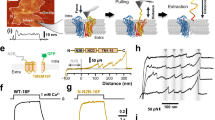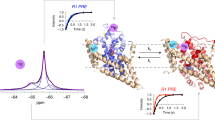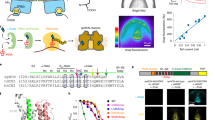Abstract
The transmembrane organization of a potassium channel from Streptomyces lividans has been studied using site directed spin labeling techniques and electron paramagnetic resonance spectroscopy. In the tetrameric channel complex, two α-helices were identified per monomer and assigned to the amino acid sequence. Probe mobility and accessibility data clearly establish that the first helix (TM1) is located in the perimeter of the channel, showing extensive protein–lipid contacts, while the second helix (TM2) is closer to the four-fold symmetric axis of the channel, lining the intracellular vestibule. A large conformational change in the C-terminal end of TM2 was measured when comparing conditions that favor either the open or closed states. The present data suggest that the diameter of the internal vestibule increases with channel opening.
This is a preview of subscription content, access via your institution
Access options
Subscribe to this journal
Receive 12 print issues and online access
$189.00 per year
only $15.75 per issue
Buy this article
- Purchase on Springer Link
- Instant access to full article PDF
Prices may be subject to local taxes which are calculated during checkout
Similar content being viewed by others
References
Hille, B. Ion channels of excitable membranes, (Sinauer, Sunderland, Massachusetts; (1992).
Miller, C. 1990: annus mirabilis of potassium channels. Science 252, 1092–1096 (1991).
Jan, L.Y. & Jan, Y.N. Potassium channels and their evolving gates. Nature 371, 119–122 (1994).
Jan, L.Y. & Jan, Y.N. Cloned potassium channels from eukaryotes and prokaryotes. Annu. Rev. Neurosci. 20, 91–123 (1997).
Schrempf, H. et al. A prokaryotic potassium ion channel with two predicted transmembrane segments from Streptomyces lividans. EMBO J. 14, 5170–5178 (1995).
Heginbotham, L., Abramson, T. & MacKinnon, R. A functional connection between the pores of distantly related ion channels as revealed by mutant K+ channels. Science 258, 1152–1155 (1992).
Heginbotham, L., Odessey, E. and Miller, C. Tetrameric stoichiometry of a prokariotic K+ channel. Biochemistry 36. 10335–10342 (1997).
Cortes, D.M. & Perozo, E. Structural dynamics of the Streptomyces lividans K+ channel (SKC1): Oligomeric stoichiometry and stability. Biochemistry 36, 10343–10352 (1997).
Tatulian, S.A., Cortes, D.M. & Perozo, E. Structural dynamics of the Streptomyces lividans K+ channel (SKC1): Secondary structure characterization from FTIR spectroscopy. FEBS Lett. 423, 205–212 (1998).
Cuello, L.G., Romero, J.G., Cortes, D.M. & Perozo, E. pH-Dependent gating in the Streptomyces lividans K+ channel. Biochemistry 37, 3229–3236 (1998).
Doyle, D.A. et al. The structure of the potassium channel: molecular basis of K+ conduction and selectivity. Science 280, 69–77 (1998).
Hubbell, W.L. & Altenbach, C. Site-directed spin labeling of membrane proteins, (Oxford University Press, New York; 1994).
Hubbell, W.L., McHaourab, H.S., Altenbach, C. & Lietzow, M.A. Watching proteins move using site-directed spin labeling. Structure 4, 779–783 (1996).
Falke, J.J. et al. Structure of a bacterial sensory receptor. A site-directed sulfhydryl study. J. Biol. Chem. 263, 14850–14858 (1988).
Rabenstein, M.D. & Shin, Y.K. Determination of the distance between two spin labels attached to a macromolecule. Proc. Natl. Acad. Sci. USA 92, 8239–8243 (1995).
Hustedt, E.J., Smirnov, A.I., Laub, C.F., Cobb, C.E. & Beth, A.H. Molecular distances from dipolar coupled spin-labels—the global analysis of multifrequency continuous wave electron paramagnetic resonance data. Biophys. J. 72, 1861–1877 (1997).
Mchaourab, H.S., Oh, K.J., Fang, C.J. & Hubbell, W.L. Conformation of T4 lysozyme in solution. Hinge-bending motion and the substrate-induced conformational transition studied by site-directed spin labeling. Biochemistry 36, 307–316 (1997).
Altenbach, C., Marthi, T., Khorana, H.G. & Hubbell, W.L. Transmembrane protein structure: spin labeling of bacteriorhodopsin mutants. Science 248, 1088–1092 (1990).
Shin, Y.K., Levinthal, C., Levinthal, F. & Hubbell, W.L. Colicin E1 binding to membranes: time-resolved studies of spin-labeled mutants. Science 259, 960–963 (1993).
Steinhoff, H.J. et al. Time-resolved detection of structural changes during the photocycle of spin-labeled bacteriorhodopsin. Science 266, 105–107 (1994).
Oh, K.J. et al. Organization of diphtheria toxin T domain in bilayers: a site-directed spin labeling study. Science 273, 810–812 (1996).
Farrens, D.L., Altenbach, C., Yang, K., Hubbell, W.L. & Khorana, H.G. Requirement of rigid-body motion of transmembrane helices for light activation of rhodopsin. Science 274, 768–770 (1996).
Subczynski, W.K. & Hyde, J.S. The diffusion-concentration product of oxygen in lipid bilayers using the spin-label T1 method. Biochim. Biophys. Acta 643, 283–291 (1981).
Altenbach, C., Froncisz, W., Hyde, J.S. & Hubbell, W.L. Conformation of spin-labeled melittin at membrane surfaces investigated by pulse saturation recovery and continuous wave power saturation electron paramagnetic resonance. Biophys. J. 56, 1183–1191 (1989).
Mchaourab, H.S., Lietzow, M.A., Hideg, K. & Hubbell, W.L. Motion of spin-labeled side chains in T4 lysozyme. Correlation with protein structure and dynamics. Biochemistry 35, 7692–7704 (1996).
Eisenberg, D., Weiss, R.M. & Terwifliger, T.C. The hydrophobic moment detects periodicity in protein hydrophobicity. Proc. Natl. Acad. Sci. USA 81, 140–144 (1984).
Cornette, J.L. et al. Hydrophobicity scales and computational techniques for detecting amphipathic structures in proteins. J. Moi. Biol. 195, 659–685 (1987).
Altenbach, C., Greenhalgh, D.A., Khorana, H.G. & Hubbell, W.L. A collision gradient method to determine the immersion depth of nitroxides in lipid bilayers: application to spin-labeled mutants of bacteriorhodopsin. Proc. Natl. Acad. Sci. USA 91, 1667–1671 (1994).
Kulikov, A.V., Likhtenshtein, G.I., Rozantsev, E.G. & Suskina, V.I. Possibility of determining the distances between the functional groups of proteins by the method of paramagnetic labels. Biofizika 17, 42–48 (1972).
Holmgren, M., Smith, P.L. & Yellen, G. Trapping of organic blockers by closing of voltage-dependent K+ channels: evidence for a trap door mechanism of activation gating. J. Gen. Phys. 109, 527–535 (1997).
Liu, Y., Holmgren, M., Jurman, M.E. & Yellen, G. Gated access to the pore of a voltage-dependent K+ channel. Neuron 19, 175–184 (1997).
Walther, D., Eisenhaber, F. & Argos, P. Principles of helix-helix packing in proteins - the helical lattice superposition model. J. Mol. Biol. 255, 536–553 (1996).
Bowie, J.U. Helix packing angle preferences. Nature Struct. Biol. 4, 915–917 (1997).
Mingarro, I., Elofsson, A. & Vonheijne, G. Helix-helix packing in a membrane-like environment. J. Mol. Biol. 272, 633–641 (1997).
Connolly, M.L. Solvent-accessible surfaces of proteins and nucleic acids. Science 221, 709–713 (1993).
Lopez, G.A., Jan, Y.N. & Jan, L.Y. Evidence that the 56 segment of the Shaker voltage-gated K+ channel comprises part of the pore. Nature 367, 179–182 (1994).
Choi, K.L Mossman, C Aube, J. & Yellen, G. The internal quaternary ammonium receptor site of Shaker potassium channels. Neuron 10, 533–541 (1993).
Shieh, C.C. & Kirsch, G.E. Mutational analysis of ion conduction and drug binding sites in the inner mouth of voltage-gated K+ channels. Biophys. J. 67, 2316–2325 (1994).
Lu, Z. & MacKinnon, R. Electrostatic tuning of Mg2+ affinity in an inward-rectifier K+ channel. Nature 371, 243–246 (1994).
Armstrong, C.M. Time course of TEA+-induced anomalous rectification in squid giant axons. J. Gen. Phys. 50, 491–503 (1966).
Armstrong, C.M., Swenson, R.P., & Taylor, S.R. Block of squid axon K channels by internally and externally applied barium ions. J. Gen. Phys. 80, 663–682 (1982).
Miller, C., Latorre, R. & Reisin, I. Coupling of voltage-dependent gating and Ba++ block in the high-conductance, Ca++-activated K+ channel. J. Gen. Phys. 90, 427–449 (1987).
Grissmer, S. & Cahalan, M.D. Divalent ion trapping inside potassium channels of human T lymphocytes. J. Gen. Phys. 93, 609–630 (1989).
Sun, Z.P., Akabas, M.H., Goulding, E.H., Karlin, A. & Siegelbaum, S.A. Exposure of residues in the cyclic nucleotide-gated channel pore: P region structure and function in gating. Neuron 16, 141–149 (1996).
Garty, H., Rudy, B. & Karlish, S.J. A simple and sensitive procedure for measuring isotope fluxes through ion-specific channels in heterogenous populations of membrane vesicles. J. Biol. Chem. 258, 13094–13099 (1983).
Becktel, W.J. & Schellman, J.A. Protein stability curves. Biopolymers 26, 1859–1877 (1987).
Farahbakhsh, Z.T., Altenbach, C. & Hubbell, W.L Spin labeled cysteines as sensors for protein-lipid interaction and conformation in rhodopsin. Photochemistry & Photobiology 56, 1019–1033 (1992).
Donnelly, D.M, Overington, J.P. & Blundell, T.L. The prediction and orientation of alpha-helices from sequence alignments: the combined use of environment-dependent substitution tables, Fourier transform methods and helix capping rules. Prot. Engng. 7, 645–653 (1994).
Author information
Authors and Affiliations
Corresponding author
Rights and permissions
About this article
Cite this article
Perozo, E., Cortes, D. & Cuello, L. Three-dimensional architecture and gating mechanism of a K+ channel studied by EPR spectroscopy. Nat Struct Mol Biol 5, 459–469 (1998). https://doi.org/10.1038/nsb0698-459
Received:
Accepted:
Issue Date:
DOI: https://doi.org/10.1038/nsb0698-459
This article is cited by
-
Characterization of the Lipid Binding Pocket in GM2AP and SapB with EPR Spectroscopy
Applied Magnetic Resonance (2018)
-
Expression and Purification of the Pain Receptor TRPV1 for Spectroscopic Analysis
Scientific Reports (2017)
-
Structural Dynamics of the MscL C-terminal Domain
Scientific Reports (2017)
-
Structure, inhibition and regulation of two-pore channel TPC1 from Arabidopsis thaliana
Nature (2016)
-
Structure of an E. coli integral membrane sulfurtransferase and its structural transition upon SCN− binding defined by EPR-based hybrid method
Scientific Reports (2016)



